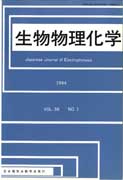All issues

Successor
Volume 38 (1994)
- Issue 6 Pages 343-
- Issue 5 Pages 273-
- Issue 4 Pages 221-
- Issue 3 Pages 121-
- Issue 2 Pages 57-
- Issue 1 Pages 1-
Volume 38, Issue 6
Displaying 1-10 of 10 articles from this issue
- |<
- <
- 1
- >
- >|
-
with special reference to our findingsAkira Yachi1994Volume 38Issue 6 Pages 343-348
Published: December 15, 1994
Released on J-STAGE: March 31, 2009
JOURNAL FREE ACCESSDownload PDF (7232K) -
1994Volume 38Issue 6 Pages 349-383
Published: December 15, 1994
Released on J-STAGE: March 31, 2009
JOURNAL FREE ACCESSDownload PDF (18974K) -
Kazuhiko Miyake1994Volume 38Issue 6 Pages 385-390
Published: December 15, 1994
Released on J-STAGE: March 31, 2009
JOURNAL FREE ACCESSDownload PDF (2809K) -
Yuhsaku Kanoh, Hideki Otani1994Volume 38Issue 6 Pages 391-396
Published: December 15, 1994
Released on J-STAGE: March 31, 2009
JOURNAL FREE ACCESSWe found 11 cases with extremely low level of α2 macroglobulin in serum (α2 macroglobulin deficiency). All of them were patients with advanced prostate cancer. Their sera gave no precipitation line on immunoelectrophoresis with antisera against α2 macroglobulin and against whole human serum. The serum levels were determined to be below approximately 10mg/dl with Laser-nephelometry. The gene conformation in one patient was determined to have no change by PCR test. On the other hand, the Western-blotting after SDS-PAGE separation of the sera in the three patients showed many bands at the position of smaller size (≤360K dalton) that were assigned to the fragments of α2 macroglobulin, and only trace amount of whole α2 macroglobulin (720K dalton) was detected. These results suggest that the deficiency developed from the acceleration of α2 macroglobulin degradation rather than suppression of the production.View full abstractDownload PDF (2722K) -
Tomohiro Hayashi, Yumiko Hayakawa, Kenji Niiya, Nobuo Sakuragawa1994Volume 38Issue 6 Pages 397-402
Published: December 15, 1994
Released on J-STAGE: March 31, 2009
JOURNAL FREE ACCESSTwo major regulatory mechanisms operating in the blood coagulation cascade are known. One is the neutralization of thrombin by antithrombin (AT), the other is the proteolytic inactivation of procoagulant cofactors Va and VIIIa by activated protein C (APC). AT is a member of the serine protease inhibitors (SERPINs), and the major plasma inhibitor of activated serine proteinases including thrombin. After its binding to heparin-like substance on the vascular endothelial cells, the formation of complexes between thrombin and AT is accelerated by 1, 000-fold to efficiently inactivate thrombin. The zymogen protein C is converted to APC by a thrombin-thrombomodulin complex on the surface of endothelial cells. The formed APC downregulates the coagulation cascade by inactivation of Va and VIIIa in the presence of its cofactor protein S (PS), and also enhances the fibrinolytic system by inhibition of plasminogen activator inhibitor 1. The importance of these factors (AT, PC and PS) as natural anticoagulants is manifested by the clinical observations that the patients with congenital deficiency or abnormality of each factor are suffering from severe thrombotic disorders. Hence, measurements of the factors in the patients with thrombotic diseases are of most important in understanding pathophysiology of the diseases.View full abstractDownload PDF (2002K) -
Yukinobu Uchiyama1994Volume 38Issue 6 Pages 403-410
Published: December 15, 1994
Released on J-STAGE: March 31, 2009
JOURNAL FREE ACCESSDownload PDF (878K) -
Yukio Sakiyama1994Volume 38Issue 6 Pages 411-416
Published: December 15, 1994
Released on J-STAGE: March 31, 2009
JOURNAL FREE ACCESSDownload PDF (1870K) -
II. Modified general procedure and an application to isoelectric focusing of proteins using immobilized pH gradientKazuo Shimao1994Volume 38Issue 6 Pages 417-423
Published: December 15, 1994
Released on J-STAGE: March 31, 2009
JOURNAL FREE ACCESSMy computer simulation procedure was applied to isoelectric focusing of proteins using immobilized pH gradient formed by Immobilines. The results for small amount of proteins (micromole order of proteins on a medium 4cm long, 10cm wide and 0.1cm thick) agreed well with those of widely reported experiments, while simulations for very large amount (10 to 100 times the above amount) of proteins with slightly differing isoelectric points resulted in a pattern that could be expressed as zero-velocity isotachophoretic separation of proteins.View full abstractDownload PDF (563K) -
Toshihiko Miura, Shigemitu Yabuki, Tadao Funato, Shigenori Tsubo, Sach ...1994Volume 38Issue 6 Pages 425-431
Published: December 15, 1994
Released on J-STAGE: March 31, 2009
JOURNAL FREE ACCESSRecent data have demonstrated that a capillary electrophoresis (CE) using untreated fused silica capillary has some advantages for separation of proteins or other substances. It is, however, necessary to minimize nonspecific adsorption of proteins to the wall, which cause decreased reproducibility. In order to overcome this problem, we extended a CE method by adding trimethylammoniumpropanesulfonate (Z1-methyl) as a zwitterion to running buffer, where the pH was raised above the isoelectric points of sample proteins. We also checked the optical condition for the separation of human serum proteins. The results showed that the use of 50mM sodium borate (pH 10.0) including 1.0M Z1-methyl gave a reproducible and more evident separation pattern at the analysis of human serum proteins. These results indicate that CE with Z1-methyl was useful method on a clinical laboratory.View full abstractDownload PDF (710K) -
Masayuki Sakagami, Takashi Hirano, Suguru Mashima, Harutaka Mukoyama1994Volume 38Issue 6 Pages 433-435
Published: December 15, 1994
Released on J-STAGE: March 31, 2009
JOURNAL FREE ACCESSDownload PDF (1508K)
- |<
- <
- 1
- >
- >|